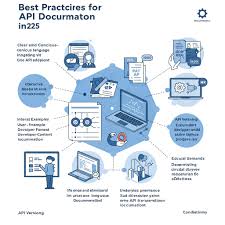In today’s hyperconnected digital world, Application Programming Interfaces (APIs) are the backbone of modern software systems. Whether you’re building a mobile app, a SaaS platform, or a microservices ecosystem, your API is likely the bridge between your product and its users or third-party developers. But a powerful API is only as good as its documentation.
As we move through 2025, developers expect clear, interactive, and intelligent documentation that not only describes the API but enables innovation. This article explores the best practices for creating and maintaining high-quality API documentation in 2025.
🧭 1. Start With the Audience
Your documentation should speak directly to its intended users—developers, integrators, or internal teams. Segment your audience and provide:
-
Quick starts for beginners
-
Deep dives for experienced developers
-
Use-case-driven examples for product managers and analysts
Pro tip: Use persona-based documentation paths. Let users choose their level of expertise or use case at the beginning.
🛠 2. Automate With OpenAPI (But Don't Stop There)
Use OpenAPI 3.1+ (formerly Swagger) to generate consistent and machine-readable documentation. Tools like Stoplight, Redocly, and Postman now offer advanced integrations that build on OpenAPI specifications.
However, remember: auto-generated docs are not enough. Supplement them with:
-
Detailed explanations
-
Code snippets in multiple languages
-
Real-world scenarios
⚡ 3. Make It Interactive
Static docs are outdated. In 2025, the standard is live, interactive documentation with:
-
“Try it out” functionality using test environments
-
Authentication walkthroughs (OAuth2, API keys, JWT)
-
Response previews and error simulations
Tools like Swagger UI, Postman Flows, and RapidDoc make interactivity simple and elegant.
📚 4. Use Consistent Structure and Language
Structure is key. A good API doc layout includes:
-
Overview / Introduction
-
Authentication
-
Rate limits / Pagination
-
Endpoint references
-
Error handling
-
SDKs / libraries
-
FAQs
Write in a consistent tone, use active voice, and avoid jargon. Even advanced developers appreciate clarity.
📦 5. Provide SDKs, Code Samples & Postman Collections
Developers love ready-to-use code. Support your API with:
-
Auto-generated SDKs (in Python, JavaScript, Go, etc.)
-
Language-specific usage examples
-
Downloadable Postman Collections or Insomnia configs
Prefer copy-pasteable code over verbose instructions.
🔍 6. Implement Search and Cross-Linking
Make your documentation searchable and interlinked. A good search function reduces frustration and helps devs solve problems faster.
-
Use Algolia or DocSearch for blazing-fast indexing
-
Add internal links between related endpoints, parameters, and errors
🧠 7. Embrace AI and Natural Language Interfaces
AI is reshaping API docs in 2025. Some modern practices:
-
AI assistants embedded in documentation (think ChatGPT for your docs)
-
Natural language query interfaces that convert plain English into API calls
-
Smart suggestions and autocomplete for request building
Platforms like ReadMe and Speakeasy are leading the charge in AI-powered documentation experiences.
🧪 8. Test Documentation as You Test Code
Documentation should be treated as living code:
-
Use CI/CD pipelines to test examples, SDKs, and sample calls
-
Validate OpenAPI specs continuously
-
Add unit tests to ensure documentation accuracy
This keeps your docs from going stale—an all-too-common problem.
🌍 9. Internationalize & Localize
If your API serves a global audience, multilingual documentation is not optional. Use localization tools to translate content and adjust examples based on regional formats (date/time, currency, etc.).
📈 10. Monitor Usage and Collect Feedback
Track which parts of your documentation are used the most (and least). Tools like:
-
Google Analytics (with privacy considerations)
-
Feedback widgets ("Was this helpful?")
-
Heatmaps or scroll depth analysis
…help you prioritize improvements.
Conclusion: Treat Docs as a Product
In 2025, API documentation is not just a developer task—it’s part of your product experience.
Great documentation can:
-
Accelerate onboarding
-
Reduce support requests
-
Boost API adoption
-
Build developer trust
So invest the time, use the right tools, and iterate regularly.
✨ Bonus Checklist for 2025 API Docs
-
✅ OpenAPI 3.1+ support
-
✅ Interactive “try it” mode
-
✅ Code snippets in at least 3 languages
-
✅ Authentication and error handling examples
-
✅ AI-powered search or chat assistant
-
✅ Versioning and changelog
-
✅ SDKs or Postman Collections
-
✅ Responsive, mobile-friendly layout
💬 What’s Your Favorite API Documentation Tool in 2025?
Let us know in the comments or share your thoughts on X (Twitter), LinkedIn, or Facebook. Happy documenting!




Leave a Reply